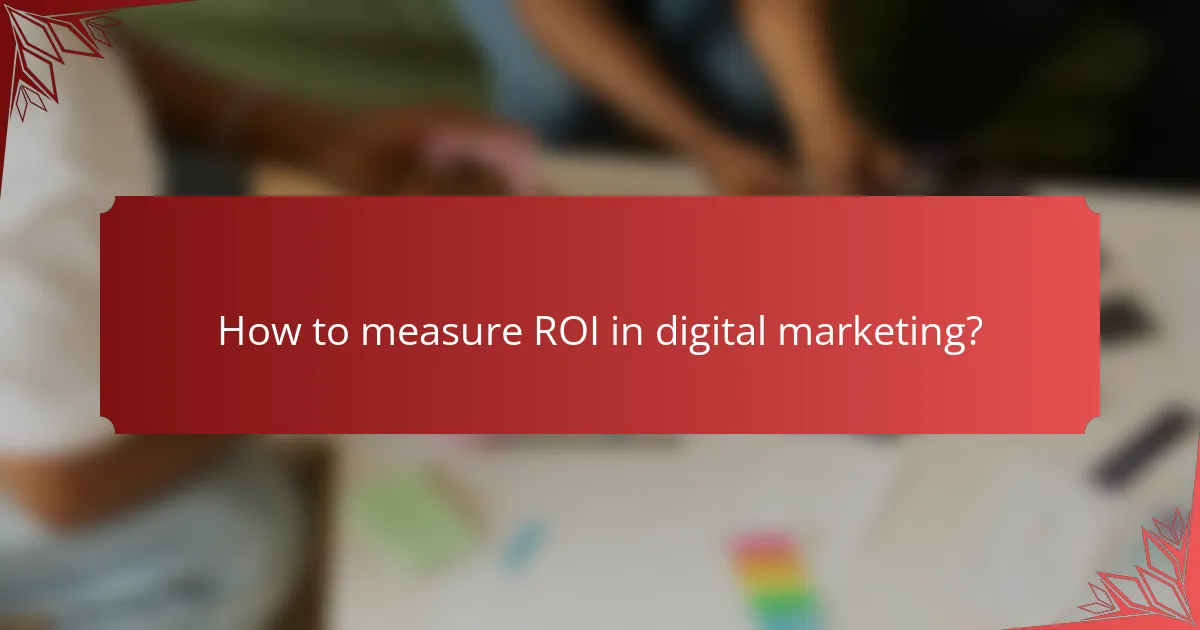In the realm of digital marketing, understanding key metrics such as ROI, conversion rates, and engagement levels is crucial for optimizing campaign performance. Measuring ROI allows businesses to assess the effectiveness of their marketing investments, while improving conversion rates focuses on enhancing user experience to drive desired actions. Additionally, fostering engagement levels through meaningful interactions can significantly strengthen brand-audience relationships.

How to measure ROI in digital marketing?
Measuring ROI in digital marketing involves calculating the return on investment from your marketing efforts compared to the costs incurred. This metric helps businesses understand the effectiveness of their campaigns and make informed decisions about future investments.
ROI formula for digital campaigns
The basic ROI formula for digital campaigns is: ROI = (Net Profit / Cost of Investment) x 100. Net profit is calculated by subtracting the total costs of the campaign from the revenue generated. This formula provides a percentage that indicates the profitability of your marketing efforts.
For example, if a campaign costs $1,000 and generates $5,000 in revenue, the net profit is $4,000. Plugging these numbers into the formula gives an ROI of 400%. Understanding this formula allows marketers to evaluate the success of various campaigns and allocate budgets accordingly.
Tools for calculating ROI
Several tools can assist in calculating ROI for digital marketing campaigns. Google Analytics is a popular choice, providing insights into traffic sources, conversion rates, and revenue tracking. Additionally, platforms like HubSpot and Marketo offer built-in ROI calculators that simplify the process.
Using spreadsheets can also be effective for custom calculations. By inputting your data and applying the ROI formula, you can tailor the analysis to your specific needs. Ensure that you consistently track all relevant costs and revenues to maintain accuracy in your calculations.
Case studies of successful ROI measurement
One notable case study involved a retail brand that implemented targeted email marketing. By tracking the costs associated with the campaign and the revenue generated from sales attributed to the emails, they calculated an ROI of over 300%. This success led them to increase their email marketing budget significantly.
Another example is a SaaS company that used social media advertising. They meticulously tracked their ad spend and the resulting subscriptions. By measuring the ROI, they discovered that their social media ads yielded a 250% return, prompting them to refine their targeting strategies further.

What are effective conversion rate strategies?
Effective conversion rate strategies focus on optimizing the user experience to encourage desired actions, such as purchases or sign-ups. Key elements include clear calls to action, streamlined navigation, and targeted messaging that resonates with your audience.
Best practices for improving conversion rates
To enhance conversion rates, prioritize user-friendly website design and ensure that your calls to action are prominent and compelling. A/B testing different elements, such as headlines and button colors, can reveal what resonates best with your visitors.
Additionally, consider using social proof, such as testimonials or case studies, to build trust. Offering limited-time promotions or guarantees can create urgency, prompting users to take action sooner.
Tools for tracking conversion rates
Several tools can help you track and analyze conversion rates effectively. Google Analytics is a popular choice, providing insights into user behavior and conversion funnels. Other options include HubSpot, which offers comprehensive marketing analytics, and Optimizely, which specializes in A/B testing.
Using these tools, you can set up goals to measure specific actions, such as form submissions or product purchases, and monitor how changes impact your conversion rates over time.
Examples of high-converting landing pages
High-converting landing pages often feature a clean design, a strong headline, and a clear value proposition. For instance, Dropbox’s landing page effectively communicates its benefits with a simple sign-up form and a compelling offer.
Another example is Airbnb, which uses high-quality images and user-generated content to engage visitors. These pages typically include minimal distractions and focus on guiding the user toward a specific action, such as booking a stay or signing up for an account.

How to enhance engagement levels in digital marketing?
Enhancing engagement levels in digital marketing involves creating meaningful interactions between brands and their audiences. This can be achieved through targeted content, personalized communication, and active participation across various platforms.
Techniques for boosting engagement
To boost engagement, brands can utilize interactive content such as polls, quizzes, and live videos. These formats encourage audience participation and can significantly increase the time spent on a website or social media page.
Another effective technique is personalization. Tailoring messages and offers based on user behavior and preferences can lead to higher engagement rates. For instance, sending personalized emails based on previous purchases can make customers feel valued and more likely to interact with the brand.
Metrics for measuring engagement
Key metrics for measuring engagement include click-through rates (CTR), social media shares, comments, and time spent on site. These indicators provide insights into how well content resonates with the audience.
Another important metric is the engagement rate, which is calculated by dividing the total engagement (likes, shares, comments) by the total reach or impressions. This helps assess the effectiveness of campaigns and identify areas for improvement.
Successful engagement campaigns in the UK
In the UK, brands like Innocent Drinks have successfully engaged their audience through humorous and relatable social media content. Their playful tone and interactive posts encourage followers to participate and share their experiences.
Another example is the BBC, which uses audience feedback to shape its content. By actively soliciting viewer opinions and incorporating them into programming, the BBC fosters a strong sense of community and engagement among its audience.

What frameworks exist for evaluating digital marketing metrics?
Evaluating digital marketing metrics involves frameworks that help assess performance through various indicators. These frameworks focus on key metrics such as ROI, conversion rates, and engagement levels to provide insights into the effectiveness of marketing strategies.
Key performance indicators (KPIs) for digital marketing
Key performance indicators (KPIs) are essential for measuring the success of digital marketing efforts. Common KPIs include return on investment (ROI), conversion rates, click-through rates (CTR), and customer acquisition costs (CAC). Each of these metrics provides valuable insights into different aspects of marketing performance.
For example, a high ROI indicates that your marketing campaigns are generating more revenue than they cost, while a strong conversion rate shows that a significant percentage of visitors are taking desired actions. Regularly tracking these KPIs helps marketers make informed decisions and optimize their strategies.
Benchmarking against industry standards
Benchmarking against industry standards allows businesses to compare their performance with competitors and identify areas for improvement. This process involves analyzing average metrics within a specific industry to set realistic goals and expectations. For instance, the average conversion rate for e-commerce sites typically ranges from 1% to 3%.
To effectively benchmark, gather data from reliable sources such as industry reports or analytics platforms. Regularly review these benchmarks to ensure your marketing efforts remain competitive. Avoid complacency by adjusting your strategies based on shifts in industry standards and emerging trends.

What are the latest trends in digital marketing metrics?
The latest trends in digital marketing metrics focus on enhanced analytics, the integration of artificial intelligence, and the impact of privacy regulations. Marketers are increasingly adopting sophisticated tools to measure return on investment (ROI), conversion rates, and engagement levels, while navigating new privacy laws that affect data collection.
Emerging tools for analytics
New analytics tools are transforming how marketers track performance metrics. Platforms like Google Analytics 4 and HubSpot are incorporating machine learning to provide deeper insights into user behavior and engagement. These tools allow for real-time data analysis, enabling marketers to make informed decisions quickly.
Additionally, visualization tools such as Tableau and Power BI help in presenting complex data in an easily digestible format. This aids in understanding trends and patterns, making it simpler to adjust strategies based on performance metrics.
Future of AI in measuring marketing effectiveness
Artificial intelligence is set to revolutionize how marketing effectiveness is measured. AI can analyze vast amounts of data to identify trends that human analysts might miss, leading to more accurate predictions of campaign success. For example, AI-driven algorithms can optimize ad placements based on user interactions, improving conversion rates significantly.
Moreover, AI tools can automate reporting processes, saving time and reducing human error. As these technologies evolve, marketers will need to adapt their strategies to leverage AI capabilities effectively, ensuring they remain competitive in a data-driven landscape.
Impact of privacy regulations on data collection
Privacy regulations like the General Data Protection Regulation (GDPR) in Europe and the California Consumer Privacy Act (CCPA) in the United States are reshaping data collection practices. These laws require marketers to obtain explicit consent from users before collecting personal data, which can limit the availability of information for analytics.
Marketers must now prioritize transparency and user trust, focusing on ethical data collection methods. Implementing strategies such as first-party data collection and anonymizing user data can help comply with regulations while still gathering valuable insights for measuring marketing effectiveness.
